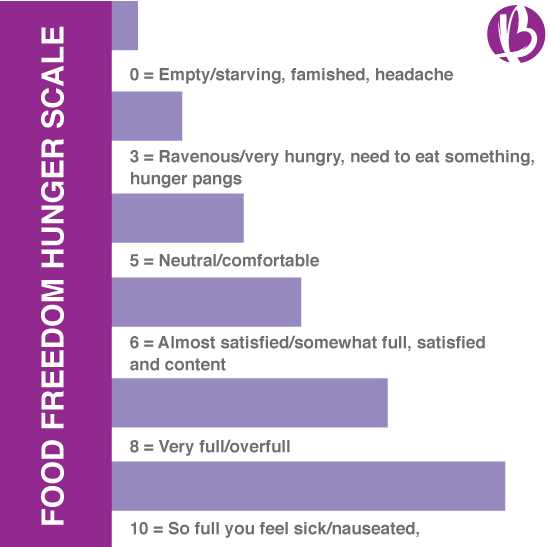Ditch the Diet: How to Know If You’re Hungry
Hunger, a natural biological cue, lets you know your body needs fuel. Often, when women diet chronically, they continue to deny their biological hunger. Over time, they experience a compensatory biological reaction and lose the ability to determine if they’re hungry. If you don’t respond to hunger knocking on your internal door, eventually it will stop knocking! When hunger stops “knocking,” eating occurs in response to other stimuli rather than true hunger. This most often leads directly to emotional eating and rebound binges.
That’s why it’s vital for you to become familiar with recognizing hunger–to learn how to know if you’re truly hungry!
Recognizing Hunger: What is it?
Although we often use the word hunger to describe a mere desire to eat, the term hunger in it’s basic form refers only to the biological need to eat.
One part of finding food freedom and learning how to end emotional eating and food obsession is learning to determine your hunger cues and honor those signs of true physical hunger.
With time, you can retrain yourself to recognize and respond to your body’s hunger and fullness signals and prevent emotional eating or eating simply from the mere desire to eat.
Hunger is not something to be feared. Rather it should be embraced and seen as a valuable communication tool your body uses to keep you healthy.
Recognizing Hunger: What keeps you from knowing if you’re hungry?
Stress, as well as food rules, beliefs and thoughts that originate in our brain, often disrupt our body’s signals of hunger.
Many women find it hard to determine when they’re hunger or to respond to hunger cues in a timely manner due to stress. Whether it’s fighting deadlines at work or changing diapers at all hours of the night, living in a constant state of stress raises cortisol levels and triggers your body’s natural fight or flight survival system.
When under chronic stress either mentally or physically (think: sleep deprivation), your blood flow shifts away from your digestive system and directs itself towards your extremities in order to help you either flee or fight the stressor. This results in a lack of hunger cues.
Balancing stress and taking time for self-care is an important step in listening to your body’s hunger cues and determining if you’re truly hungry. Your daily routine, relationships and environment all impact your body’s ability to determine hunger.
Recognizing Hunger: What are signs that your body is hungry?
Mood changes, energy changes, and increased thoughts about food signal hunger. The longer you wait to give your body the fuel that it needs, the more intense these experiences become.
Likewise, the more you listen to your body and tune in to your own personal hunger cues, the more quickly you’ll be able to recognize these signs. When we begin recognizing hunger, we meet this need for fuel before experiencing the compensatory biological reactions.

When you begin to pay attention to these signs, you easily identify patterns in your hunger symptoms and levels. Then you can correlate them with how often you eat and how much you ate at your last meal. It may take some time for you to get comfortable with identifying normal levels of hunger. You need to recognize the pattern of eating that best suits you individually (small, light, more frequent meals vs. 3 larger meals, etc).
Be patient with yourself and your body. Take the time to listen and care for yourself. Finally, get back in tune with your body. It’s worth it!
Recognizing Hunger: The Food Freedom Hunger Scale
As you learn to retrain your body to determine your own hunger cues, the food freedom hunger scale proves significantly helpful. Begin paying attention to the different levels of hunger and the individual signals that your body sends to you at various stages.
Check in with your body throughout the day and “rate” your hunger. A common way to rate hunger is on a scale of one to ten with one equivalent to a state of starving and ten equivalent to a state of extreme fullness or being overstuffed.
Ideally, you would want to initiate a meal when you feel a state of hunger but not completely famished (a scale rating of about two to four). Then you want to finish a meal when you are in a state of fullness but not completely stuffed (a scale rating of approximately five to seven).
Food Freedom Hunger Scale

Note: Normal hunger cues occur 3 to 5 hours after eating, and it takes a while for the signal of stomach fullness to reach the satiety centers in your brain. So, part of learning how to eat for true hunger includes knowing how to stop eating before you feel overly full.
Challenge: Begin paying attention to your body’s hunger signals. Keep track of your hunger rating, and how various foods impact your hunger, energy and cravings.
P.S. It’s time that we change unproductive behaviors and DITCH the DIET once and for all!
Click below to get my FREE 7 Day Food Freedom blog series delivered to your inbox. And learn more about our 21 Day Food Freedom Challenge waiting list to claim your discount! Learn how to end your emotional eating, food obsession and self sabotage–WITHOUT dieting!
